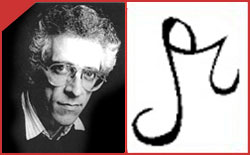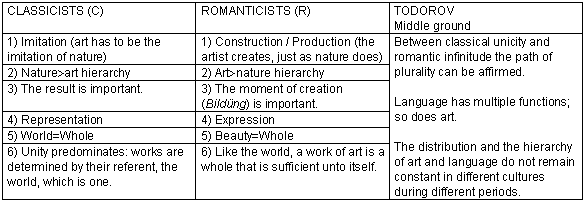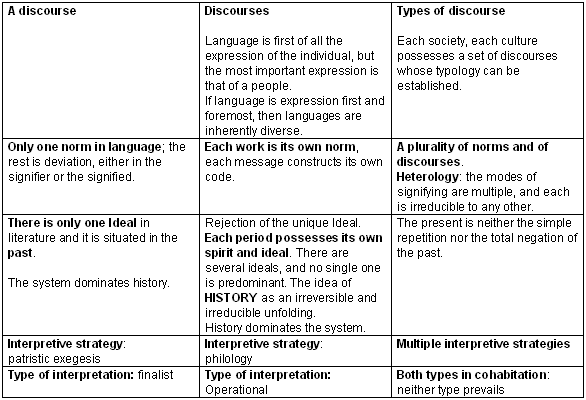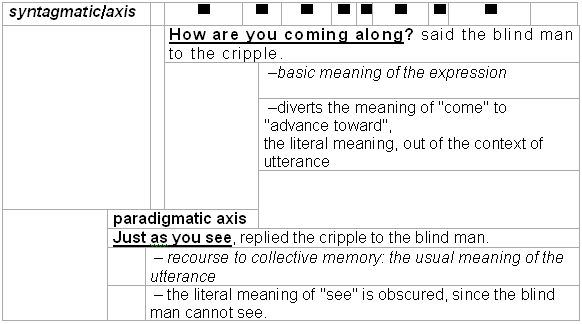Available Languages
- Consultez cette page en FRANÇAIS
- Consult this page in ENGLISH
The Semiotics of Tzvevan Todorov
By Lucie Guillemette and Josiane Cossette
Université du Québec à Trois-Rivières
1. Abstract
Todorov

Todorov's approach to semiotics cannot be dissociated from history, which he views as a fiction. His theories do not aspire to define the sign and the symbol, but instead, to present diverse approaches to them, based on different disciplines and time periods. Focusing at length on the crisis between "Classicists" and "Romanticists", Todorov draws parallels between history and semiotics in order to see how the rupture came about and what its implications were at the level of signification and interpretation.
The overall aim of Todorov's theories (1977 and 1978) is to demonstrate that the sign (or symbol) is not univocal and that several factors can cause its interpretation to vary. From his perspective, " 'semiotics' appears acceptable to me only to the extent that it is synonymous with 'symbolics' " (1982b, 17). Very briefly, whereas many of his predecessors had focused solely on the relationship between history and discourse, Todorov added in the fundamental concept of enunciation (the production of sentences – utterances – in the specific contexts of communication).
This text may be reproduced for non-commercial purposes, provided the complete reference is given:
Lucie Guillemette and Josiane Cossette (2006), « The Semiotics of Tzvetan Todorov », in Louis Hébert (dir.), Signo [online], Rimouski (Quebec), http://www.signosemio.com/todorov/semiotics.asp.
2. THEORY
2.1 CLASSICISTS VS. ROMANTICISTS: THE CRISIS
Todorov was interested in the crisis between the Classicists and the Romanticists (at the end of the 18th century), because "a radical change in the ways of thinking about the symbol occurred in this period (although the change had been long in preparation): a viewpoint that had been dominant for centuries in the West gave way to another that, I believe, still reigns today" (1982a, 10).
NOTE: PLATO AND THE CLASSICISTS
The crisis between Classicists and Romanticists was primarily a philosophical one. It echoes the ontological and aesthetic considerations found in Plato's work on the principle of imitation. (The "Classicists" are represented by those philosophers whose work is part of Plato's legacy.)
2.2 THE RELATIONSHIP BETWEEN HISTORY, LANGUAGE AND DISCOURSE
The close tie that binds language, history and discourse is the root of the signifying process, in Todorov's view. Looking at the concept of History (which in Classical thought was dominated by the system and in Romantic thought dominated the system), Todorov acknowledges that "the present is obviously neither the simple repetition nor the total negation of the past" (1982a, 290).
This basic idea influenced his thinking about language and discourse, which is also steeped in plurality. According to Todorov in Theories of the Symbol (1982a), the contemporary position is "typological, plurifunctional, heterological" (1982a, 291). Rather than a single discourse or a multiplicity of discourses that are all different from each other, Todorov speaks in terms of types of discourse, whose variations depend on the culture and the period - in short, the context of enunciation. This produces a whole string of possible standards, but without implying that each text establishes its own code.
Consequently, Todorov draws a fine distinction concerning signification as well: "the modes of signifying are multiple, and each is irreducible to any other; their difference lends itself to no value judgments whatsoever" (1982a, 291). These considerations paved the way for his symbolics of language.
The following tables present a summary of history-language-discourse relationships according to the Classicists, the Romanticists and Todorov.
General relationships between history, language and discourse

Specific relationships between history, language and discourse

2.3 LINGUISTIC SYMBOLISM
While he is aware that there are other semiotics and other symbolics, Todorov is nevertheless committed to linguistic symbolism. He starts by distinguishing between language and discourse.
2.3.1 THE LANGUAGE-DISCOURSE DISTINCTION
- Language: "has a lexicon and grammatical rules as its input and sentences as its output" (1982b, 9).
- Discourse: "is a concrete manifestation of language, and it is produced, necessarily, in a specific context that involves not only linguistic elements but also the circumstances of their production: the interlocutors, the time and place, the relations prevailing among these extralinguistic elements" (1982b, 9). This produces utterances.
2.3.2 INDIRECT MEANING
One of Todorov's contributions to semiotics lies in his emphasis on enunciation, or the conditions in which the discourse is produced. Indirect meaning is consequently of great importance in his refusal to choose sides between the linguists (nothing exists other than what we perceive, so indirect meaning does not exist) and the Romantic poets (everything is metaphor; there is only indirect meaning).
According to Todorov, "a text or a discourse becomes symbolic at the point when, through an effort of interpretation, we discover in it an indirect meaning" (1982b, 19). For example, "it's cold in here" may signify its direct meaning: that it's cold in here. However, if it is addressed to another person in the same room as the enunciator, the same utterance may be taken indirectly by the other person to mean "close the window".
2.3.3 THE SYMBOLICS OF LANGUAGE
In order for a symbolics of language to develop, there must first be a decision to interpret. This decision is based on the principle of pertinence "according to which if a discourse exists there must be a reason for it" (1982b, 28). When a discourse does not appear to obey this rule, "the receiver's spontaneous reaction is to determine whether the discourse might not reveal its pertinence through some particular manipulation" (1982b, 28). This manipulation is in fact interpretation. One factor (following from the rule of pertinence) that influences the decision to interpret is that of textual indices. For example, the label "allegory" at the beginning of a text will prompt the receiver to seek the indirect meaning of the text, rather than stick to the literal meaning.
Once the decision to interpret has been made, several factors will influence the interpretation:
- The role of linguistic structure;
- The hierarchy of meanings;
- The direction of evocation;
- Logical structure.
We will concentrate especially on the hierarchy of meanings and the direction of evocation, each of which includes several subtopics.
2.3.4 THE HIERARCHY OF MEANINGS
The relationship between direct and indirect meaning is expressed in terms that "reveal a hierarchy - one that the user of the terms does not always recognize" (1982b, 52); In order to clarify this relationship, Todorov sketches out the problematics of the hierarchy of meanings by pinpointing and defining three types of discourse: literal, ambiguous and transparent.
- Literal discourse: discourse that signifies without evoking anything (no actual text completely achieves this, but that is what the writers of the New Novel were attempting).
- Ambiguous discourse: several meanings of the same utterance are to be taken on exactly the same level. Syntactic, semantic and pragmatic ambiguity are all possible.
- Transparent discourse: there is no attention given to the literal meaning (for example, in allegory).
2.3.5 THE DIRECTION OF SYMBOLIC EVOCATION
The direction of symbolic evocation is the choice that interlocutors make about the very direction in which the evocation is made to function. For example, a translator of Lewis Carroll's work must constantly strive to create in the French translation the direct and indirect meanings that are simultaneously present in Carroll's English puns. Below is an example in which the expression to be gone is ambiguous:
"Are their heads off?" shouted the Queen.
"Their heads are gone, if it please Your Majesty!" the soldiers shouted in reply.
To keep from sacrificing the pun, the French translators had to introduce the expression perdre la tête :
Leur a-t-on bel et bien tranché la tête ? s’enquit, à tue-tête, la reine.
Ils ont bel et bien perdu la tête, s’il plaît à votre Majesté, répondirent, à tue-tête, les soldats (Parisot, 1989 : 906).
In order to push the discourse toward ambiguity, the translators even replaced shouted with à tue-tête ("[shouting] their heads off").
2.3.5.1 THE DISTINCTION BETWEEN UTTERANCE AND ENUNCIATION
For Todorov, the distinction between utterance and enunciation is helpful in understanding the influence that the context of enunciation has on the meaning of the utterance.
- Utterance: a segment of discourse resulting from a speech act.
- Enunciation: actually refers to the context of enunciation: who produced the utterance, in what conditions, and so on.
Irony is a phenomenon that plays simultaneously on the utterance and the enunciation. If I say, "What lovely weather!" in the middle of a huge storm, my interlocutor will grasp the irony of the utterance from the paradox, but also because he has first recognized that I knew the meaning of the words and that I was fully aware of what I said (which are factors of the enunciation).
2.3.5.2 SYNTAGMATIC CONTEXT
Context has to do with the nature of the means that make it possible to establish the indirect meaning:
- Reference to the immediate syntagmatic context (what was said previously, in what circumstances, etc.).
- Recourse to collective memory (the paradigmatic context).
An utterance can be taken out of its context of enunciation in order to derive a wrong interpretation, which demonstrates the importance of taking the enunciation into account.
The conversation further below illustrates the connections between the meaning of the expression and the enunciation in context.
NOTE: SYNTAGMATIC VS. PARADIGMATIC
The diagram below shows the projection of the paradigmatic axis onto the syntagmatic axis, as formulated by Jakobson. The syntagmatic axis (the horizontal, linear axis) is the axis of conjunctions (Greimas and Courtés, 1982, 21). The syntagm, an element of the syntagmatic axis, corresponds to a unit with reference to its environment. If the environment consists of a sentence, the syntagm will be a word within the sentence; if the environment is a word, the syntagm will be a syllable, and so on. A sentence may thus be formulated as follows: article + common noun + verb + article + direct object. The "+" introduces the conjunction.
The paradigmatic axis is the axis of commutations and substitutions (Greimas and Courtés, 1982, 21). Its virtual elements are linked together by the disjunction "either … or …" (1982, 224-5). Therefore, paradigms are "elements that can occupy the same place in the syntagmatic string, or […] a set of elements each of which is substitutable for the other in the same context" (1982, 224). For example, in the sentence (syntagmatic axis) "The cat is grey", the syntagm "grey", which is an attribute, could be replaced by another attribute depending on the context: red, big, yellow, little, etc., which constitute so many paradigms.

In the previous exchange, "collective memory (here a properly linguistic one) brings to mind the current (thus head) meaning of the expressions "how are you coming along" and "as you see". The immediate syntagmatic context (the words "blind," "cripple") awakens the literal meaning of the elements constituting these expressions (come, see)" (1982b, 68). Since the blind man cannot see and the paralytic cannot "come", their shared collective memory and their membership in the same social group is what allows them to understand each other.
2.4 A SYNTHESIS OF THEORIES
In summary, Todorov changed the dyad of history/discourse into a triad consisting of history/discourse/enunciation. Since he postulates that these elements are variable, it follows that interpretation must come into play. There are two types of interpretive strategies: finalist interpretation (e.g. the patristic exegesis of the Classicists) and operational interpretation (e.g. the philology of the Romanticists).
Current strategies such as Marxist and Freudian criticism would be considered finalist interpretation, since "the destination is known in advance, and cannot be modified" (1982b, 167). Operational interpretation would be in keeping with structural analysis, as practiced by Lévi-Strauss on myths or by Jakobson on poetry. What is given in advance is not the result, but "the form of the operations to which one has the right to subject the text being analyzed" (1982b, 168). Structural analysis also places the historical context in parentheses.
Concerning these different approaches, Todorov emphasizes one point: ideology. "No interpretation is free from ideological presuppositions, and no interpretation is arbitrary in its operations" (1982b, 169). Signification, then, is a matter of interpretation and enunciation, and "the interaction between strategies of interpretation and social history passes through an essential mediation which is ideology itself" (1982b, 170).
3. APPLICATIONS
3.1 APPLICATION I: THE GOSPEL ACCORDING TO SAINT MARK
* * *
Excerpted from the Gospel According to Saint Mark (2: 21,22)
"No one sews a patch of unshrunk cloth on an old garment. If he does, the new piece will pull away from the old, making the tear worse. And no one pours new wine into old wineskins. If he does, the wine will burst the skins, and both the wine and the wineskins will be ruined. No, he pours new wine into new wineskins."
* * *
If we take these utterances literally and omit the context of enunciation, then we might actually think that they are recommendations about sewing and cooking. However, in this case the syntagmatic context is incidental to the interpretation we want to derive. Knowing that this utterance comes from the Gospel According to Saint Mark (2:21-22) and that the enunciator is Jesus, we will look for the allegorical meaning, because lacking that, the utterance is meaningless. So we must consider these utterances as illustrations. What should inform and guide our interpretation more than the garment, the wine and the wineskins is the opposition between new and old or good and bad, and how they are combined in the syntagmatic context.
In fact, these metaphors are used during the scene in which Jesus says "Get up, take your mat and walk" to a paralytic, whereupon the man is able to get up and walk. In the very same scene, just before the utterances quoted above, this is what is said (Mark 2:16-19):
"When the teachers of the law who were Pharisees saw him eating with the sinners and tax collectors, they asked his disciples: "Why does he eat with tax collectors and sinners?" On hearing this, Jesus said to them, "It is not the healthy who need a doctor, but the sick. I have not come to call the righteous, but sinners." Now John's disciples and the Pharisees were fasting. Some people came and asked Jesus, "How is it that John's disciples and the disciples of the Pharisees are fasting, but yours are not?" Jesus answered, "How can the guests of the bridegroom fast while he is with them? They cannot, so long as they have him with them. But the time will come when the bridegroom will be taken from them, and on that day they will fast." "
In this instance, Jesus is reproaching his detractors for applying a principle with no consideration given to any circumstances that might warrant an exception to it. What we have described as "recommendations about sewing and cooking" appears in this example to be a metaphorical, or even allegorical, illustration. The law was made for man, so to speak, and not man for the law. In certain circumstances – such as a wedding – it does not bode well to apply the law. Thus it is better to bypass certain rules if the repercussions could be inauspicious. The syntagmatic context is what infuses the utterances with all their meaning, and lacking that, only the first – quite insignificant – meaning is actualised.
3.2 APPLICATION II: ALISS BY PATRICK SENÉCAL
* * *
Excerpted from Aliss
Patrick Senécal (2000, 305-308)
There is a patient lying on the operating table. Naked, on his back, strapped down and immobilized. I'm not really surprised, but I'm not reassured, either. He's certainly not in this position to have tea with us. […] Set on a tripod to one side, a tray covered with surgical instruments makes me shudder. […]
"Well, there you have it. You're out of luck. Here you are, strapped on our operating table. So, now that you're on the table, it's time to sit down and eat"[il est temps de vous mettre à table].
As Bone said this last bit, he winked at his partner. Chair gave him an admiring and amused look:
"Not bad… But I think he's going to have trouble getting to the table since he's not his normal self." [Mais je crois qu’il aura de la difficulté à se mettre à table, puisqu’il n’est pas dans son assiette !]
"Ha ha! Very funny! What's important when you come to the table is to not put your foot in your mouth!"[c’est de ne pas se mettre les pieds dans les plats!]
"Ho ho! Really good one! Anyway, when you come to the table, you…"
"Oh, cut it out!" I exclaim, irritated and disoriented."
* * *
In this excerpt from the novel, several utterances are in fact idiomatic expressions, which normally should not be taken literally (like "down in the dumps", for example). A good illustration of the juxtaposition of opposing interpretive strategies, Senécal's dialogues alternate between literal meaning and usual meaning, with both possible meanings coexisting simultaneously. This is the feature we will focus on.
In this context, the expression "ne pas être dans son assiette" can simultaneously assume the usual meaning [not his normal self] through the shared collective memory and the literal meaning [not in his plate]. The character, who is apparently going to be eaten as a meal, actually does not feel very well (the usual meaning). And on the other hand, since he is lying directly on the table, he is not on a plate (the literal meaning). The same applies to "les pieds dans les plats": the character should not have put himself in such an embarrassing position (the usual meaning); he would indeed be better off not sticking his feet in the dishes (the literal meaning), given the (black) humour of his hangmen.
Moreover, this discourse could be described as ambiguous, since it can assume the literal meaning as well as the usual meaning. The syntagmatic context (what surrounds the ambiguous utterances and lets us know that an individual is lying on a table where he will be devoured) allows us to grasp the opportunity to awaken the literal meaning, while the pardigmatic context provides recourse to the shared collective memory of the actors in this scene, who all know the usual meanings of the expressions. While the Classicists went solely by the "hidden" meaning of the expression, as illustrated by the excerpt quoted above from the New Testament, the Romanticists remained consistently within the text (beauty and sufficiency unto itself) with no recourse to the collective memory. Current interpretive strategies and texts (like Aliss) enable two meanings to coexist without either one prevailing over the other.
4. list of works CITED
- PARISOT, Henri, "Pour franciser les jeux de langage d’“Alice”", in Lewis Carroll, Œuvres, ed. Francis Lacassin, Paris: Robert Laffont, 1989, p. 901-919.
- SENÉCAL, Patrick, Aliss, Beauport: Alire, 2000.
- TODOROV, Tzvetan, trans. Catherine Porter, Theories of the Symbol, Ithaca: Cornell University Press, 1982a.
- TODOROV, Tzvetan, trans. Catherine Porter, Symbolism and Interpretation, Ithaca: Cornell University Press, 1982b.
5. EXERCISES
A. Find the various meanings that the following utterances can convey depending on the context of enunciation.
- She doesn't mind.
- We're burning up.
- He couldn't swing it.
- He came in and took the bench.
- You got out of it.
- Something smells fishy.
B. In the following sentences, determine whether it is the syntagmatic or the paradigmatic context that allows an accurate understanding of the utterance.
- "You may stand down."
- The different branches of Arithmetic - Ambition, Distraction, Uglification, and Derision.
- "I can't explain myself, I'm afraid, Sir," said Alice, "because I'm not myself, you see."
- A man was found dead on his feet after hours of standing in a crowded subway car.

